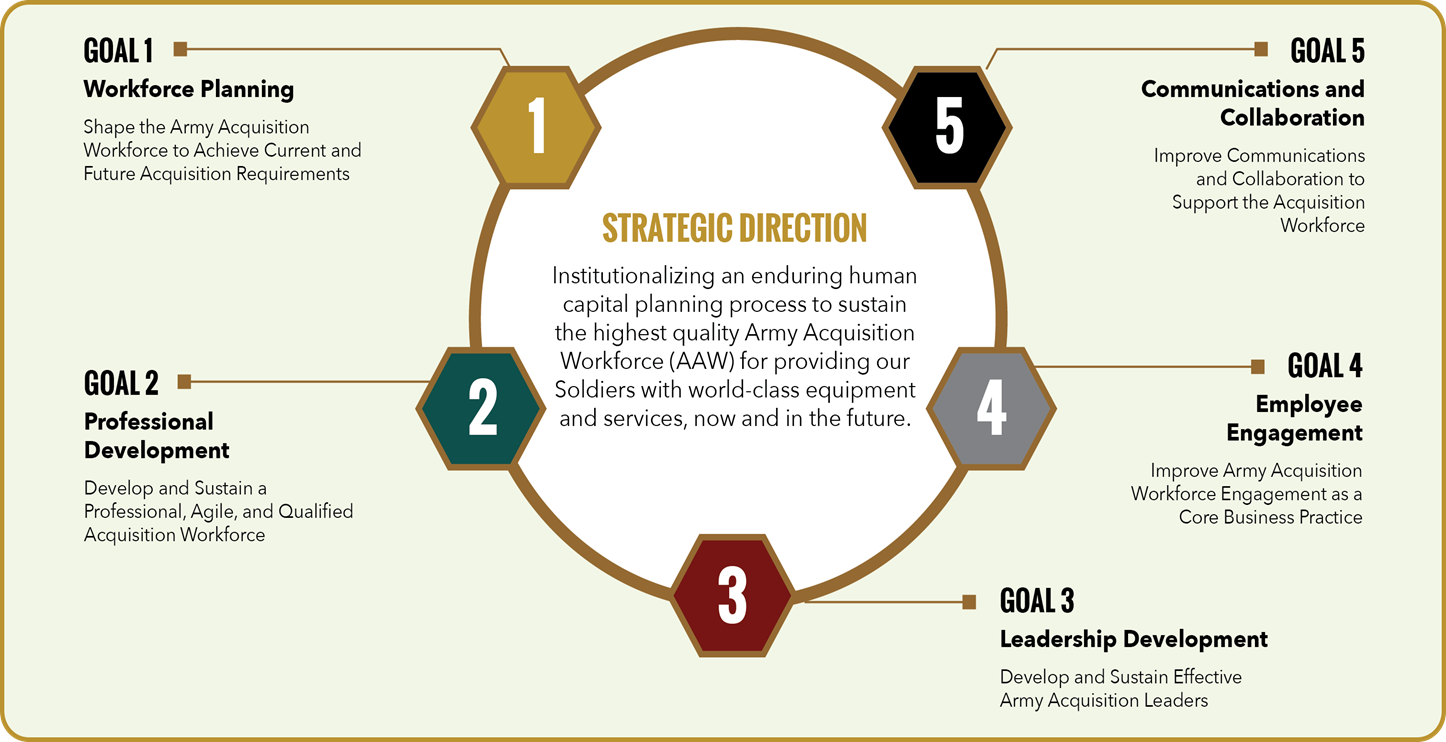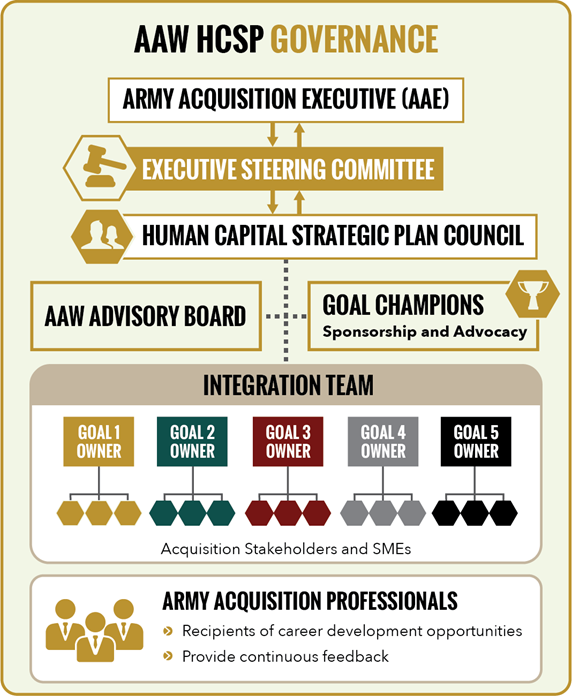
More than 30 initiatives are underway, and we’re just getting started.
by Ms. Joan L. Sable
October 2017 marks the completion of the first year of a five-year Army Acquisition Workforce (AAW) Human Capital Strategic Plan (HCSP), led by the Army Director for Acquisition Career Management (DACM) Office, an office dedicated to you and your acquisition career. This plan is a key component to support human capital management efforts and the Army’s No. 1 priority: readiness. Together, we have a responsibility to ensure that our AAW maintains a competitive edge and can face any challenge.
This investment in the AAW is supported by your senior acquisition leadership. Lt. Gen. Paul A. Ostrowski, the principal military deputy to the assistant secretary of the Army for acquisition, logistics and technology (ASA(ALT)) and the director of the Army Acquisition Corps, said in a recent discussion: “It is clear, from industry to government, from public to private sectors, that people make the difference between organizations which succeed and those that fail. By investing in people, through education, broadening opportunities and training, true leading-edge organizations are able to gain the human capital they need to dominate—so, too, must the Army, and the Human Capital Strategic Plan is designed to do just that.”
The HCSP helps to establish goals, objectives and strategic initiatives that support the development of a professional AAW. Outlined in the HCSP are five goals, addressing workforce planning, professional development, leadership development, employee engagement, and communications and collaboration. (See Figure 1.) The goals are themes or statements of purpose to align human capital strategies to the ASA(ALT) mission. Under each of the five goals are multiple objectives identifying measurable desired outcomes.

Figure 1
The Human Capital Strategic Plan, launched in October 2016, establishes five broad goals, or lines of effort, designed to ensure that the AAW is ready—well-qualified, trained, agile and responsive—to support Soldiers with world-class equipment and services. (SOURCE: Army DACM Office)
WHERE ARE WE NOW?
The official launch of the HCSP in October 2016 began with a virtual town hall attended by over 1,000 members of our Army Acquisition Workforce. Thank you for attending, sharing your thoughts and asking insightful questions. Many of your questions and concerns from the town hall regarding leadership development, certifications and workforce development reinforced the strategic initiatives selected to support each of the five goals. Additionally, the forum confirmed the need to establish a governance process to guide strategic planning and address emerging challenges. This is a team effort, and your questions and concerns directly impact the successful implementation of the HCSP.
What good is a plan, however, if there is no action towards its implementation? Since October 2016, your Army DACM Office has launched a number of strategic initiatives across the five goals outlined in the plan; in all, there are over 30 initiatives. While not all of them started last October, they represent a significant scope of activity.
WHY IS THIS IMPORTANT?
The Army outlines four pillars of readiness—manning, training, equipping and leader development—to support a full range of military operations. The Army Acquisition Workforce touches all four pillars, playing a critical role in providing modernized and ready, tailored land force capabilities to meet combatant commanders’ requirements. Acquisition professionals develop, procure, field and sustain the world’s best equipment and services by leveraging technologies and capabilities efficiently to meet current and future Army needs.
To maintain and sustain this effort to support the readiness of the Army, we continually improve the Army’s capability in all stages of materiel development by developing a professional acquisition workforce and supporting the acquisition community at all levels. How do we make the right professional development opportunities available to the workforce? AAW feedback reported through the Army Acquisition Career Development Assessment will help decision-makers focus human capital planning and investment.
How do we best address and prioritize planning, resources and emerging issues? An established governance structure enables ASA(ALT) to leverage enterprisewide knowledge and resources, reduce redundancies in programs and resources, and optimize human capital support critical to the Army mission. Two key initiatives arising from the HCSP meet the Army’s priority of readiness:
- The HCSP governance process.
- The Acquisition Career Development Assessment.
GOVERNANCE PROCESS
Creating a process to validate, prioritize and integrate human capital programs is vital to sustaining an AAW that can provide our Soldiers with world-class equipment and services, now and in the future. An institutionalized governance process meets one of the HCSP’s strategic goals: to “improve communications and collaboration.” At its core, the process puts into operation how we manage the HCSP and implement the initiatives.
Over the past year, your Army DACM Office has led efforts to create a structure, identify membership and establish a cycle of activities. The governance structure includes a mix of formal governance bodies and temporary integrated project teams. (See Figure 2.) The Army acquisition executive (AAE) has overall oversight for the governance structure, which includes four governing bodies:
- Executive Steering Committee (ESC), comprising senior Army leaders. The ESC approves the strategic direction, goals and objectives for the HCSP. It ensures accountability and senior leader focus. The first ESC meeting was in early August.
- HCSP Council: Monitors the goals and objectives and tracks progress and achievement of initiatives.
- AAW Advisory Board: Provides input from the AAW on the goals, objectives and initiatives.
- Integration team: Coordinates efforts across the Army and the Office of the Secretary of Defense, implements initiatives and develops action plans. The team consists of key stakeholders such as ASA(ALT) leadership and staff, Army DACM Office staff, Army acquisition functional leaders and advisers, organizational acquisition career management advocates, command and program executive office representatives, human capital and Army/command G-1 expertise, etc.
These governing bodies operate both from the top down and the bottom up. At the strategic level, senior leaders provide guidance as well as review. At the operational level, the HCSP Council, in conjunction with the AAW Advisory Board and goal champions (who advocate for a goal, or for objectives or initiatives within a goal), plan and manage the execution of the human capital strategy.
Last but not least, the integration team focuses on tactical execution to achieve objectives. The team’s principal function is to manage the change process and identify, integrate, leverage and catalog human capital information. The collected information is used to improve AAW human capital programs and initiatives, to ensure that strategic planning and decision-making are supported by key information, and to identify the resources needed to accomplish human capital priorities. As the Army’s priorities evolve, this governance structure supports development, coordination, alignment and integration of new initiatives.

Figure 2
Feedback from members of the AAW confirmed the need to establish a governance structure to guide the evolving process of human capital strategic planning. The HCSP calls for ongoing, two-way communication about the plan’s implementation or any emerging workforce challenges. (SOURCE: Army DACM Office)
CAREER DEVELOPMENT ASSESSMENT
For the first time, the AAW received an assessment of competency importance and skill levels specific to acquisition career-fields (ACFs). The Acquisition Career Development Assessment supports the HCSP, specifically responding to the goal “to develop and sustain a professional, agile, and qualified acquisition workforce.” The assessment was delivered via a web-enabled tool from TrueChoice Solutions Inc., uniquely modeled to capture responses from our AAW regarding:
- Proficiency in leadership competencies.
- Importance of leadership competencies.
- Proficiency in ACF-specific functional and technical competencies.
- Importance of ACF-specific functional and technical competencies.
- Allocation of time spent on work-related tasks (e.g., activities related to leadership, functional and technical competencies, training and administration).
- AAW career preferences.
Thank you to the more than 6,000 members of our AAW who took the time to participate in the inaugural assessment. Workforce members in each of the ACFs received a customized assessment, starting with the contracting ACF in March and continuing through the summer with releases for 12 additional ACFs.
The data collected from the assessment will guide decision-making in the planning and execution of initiatives through the human capital life cycle. Targeting investments in your professional development ensures that our acquisition workforce remains relevant and proficient, with the right skills and capabilities in their areas of expertise. We have programs, tools and stringent education requirements in place to ensure that our civilian and military professionals maintain a competitive edge in the acquisition community and can meet combatant commanders’ requirements across the range of military operations. We will continue to meet the needs of the nation and remain vigilant with the resources provided to us.
STAY INFORMED AND ENGAGED
If you missed the opportunity to provide feedback during the inaugural competency assessment in 2017, your Army DACM Office is working toward establishing a repeatable process for competency management to inform future professional development investments. Targeting our human capital investments based on assessed needs will ensure a ready and able AAW.
The AAW HCSP is a commitment to you, our Army Acquisition Workforce. As part of our ongoing efforts to keep the AAW informed and engaged, we will be out in the field conducting workshops at key commands and locations. This is an opportunity for two-way communication; we want to receive feedback from you about the plan’s implementation or any emerging AAW challenges.
For more information and a copy of the plan, go to http://asc. army.mil/web/hcsp. We welcome your feedback, thoughts and comments at usarmy.belvoir.usaac.mbx.usaac-aaw-hcsp@mail.mil.
JOAN L. SABLE is chief of the Human Capital Initiatives Division in the Army DACM Office. She holds an MBA from Strayer University and a B.S. in education from Longwood University, and has worked in the Army acquisition community for more than 17 years. She is Level III certified in program management and a member of the Army Acquisition Corps.
RELATED LINKS
Army Doctrine Reference Publication (ADRP) 6-22, Army Leadership, August 1, 2012 (the source document for leadership competencies (e.g., key core/nontechnical competencies that enable a leader to be innovative, adaptive and able to lead successfully in uncertain and complex operating environments).
The DOD Acquisition Workforce Qualification Initiative (AWQI) e-Workbook (the source document for functional/technical competencies (e.g., non-behavioral competencies, having explicit knowledge or ability established for a specific acquisition career field)).
This article will be published in the October – December 2017 Army AL&T magazine.
Subscribe to Army AL&T News, the premier online news source for the Acquisition, Logistics, and Technology (AL&T) Workforce.







